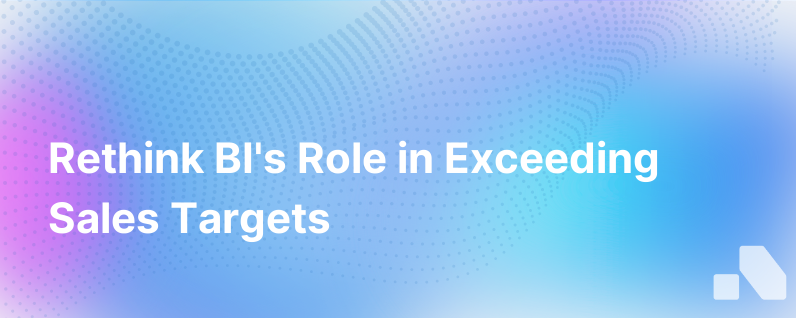
In the business sphere, it’s often touted that Business Intelligence (BI) is the golden key to unlocking unprecedented sales success – that it alone is sufficient for crushing quota after quota. There's merit to that faith; after all, BI involves analyzing data to support better business decision-making, and who doesn't want to make more informed decisions?
However, as powerful as BI is, relying solely on it to crush your sales numbers is akin to setting sail on the high seas with a map but without a compass. BI provides the map – an overview of where you could go – but without the compass – the action-guiding strategy – you may end up adrift in a vast ocean of data.
The Limitations of Business Intelligence in Sales
While BI tools can equip sales teams with valuable data insights, data alone doesn't close deals – people do. Here's where BI falls short:
-
Lack of Actionability: BI tools are great at reporting what has happened or what is happening, but they tend to fall short in prescribing what sales action to take next.
-
Overemphasis on Quantitative Data: BI focuses predominantly on quantitative metrics. But sales, being fundamentally a human endeavor, requires a nuanced understanding of qualitative factors like prospect pain points and buyer psychology, which BI doesn't capture.
-
Static Insights: Often, the insights provided by BI are static; they paint a picture of a particular moment in time but do not account for the dynamic nature of the sales landscape.
-
Isolation from Execution: BI reports can show high-potential opportunities, but they typically don't interlink with the tools and processes places that sales teams use to execute their strategies.
The Role of Sales Intelligence and Enablement
So if BI isn't the complete answer, what is? The secret sauce to crushing your sales numbers is an integrated approach that combines the insights of BI with the action-oriented processes of sales intelligence and enablement.
Sales Intelligence
Sales intelligence is about leveraging both quantitative and qualitative data. It’s about knowing not only the 'whos' and the 'whats,' but also the 'hows' and the 'whys' behind sales opportunities.
-
Real-time Insights and Triggers: Sales intelligence tools often provide real-time insights into buyer intent and behavior, enabling salespeople to engage prospects precisely when they're most receptive.
-
Integrating Multiple Data Sources: Sales intelligence goes beyond internal datasets and integrates with external sources to give a fuller picture of the market and buyer journey.
-
Predictive Analytics: Modern sales intelligence platforms use AI and machine learning to predict future buyer behavior based on historical and real-time data.
Sales Enablement
Equally critical is sales enablement, which empowers sales teams with the tools, content, and information they need to sell more efficiently.
-
Content that Converts: From case studies to personalized presentations, sales enablement provides materials that can help guide a prospect through their decision-making process.
-
Training and Coaching: Sales enablement includes training sessions and coaching for improving selling skills and strategies.
-
Integration with CRM and Sales Processes: Enabling teams to turn insight into action needs to be seamlessly integrated with CRM systems and sales processes.
Synthesizing BI with Sales Intelligence and Enablement
For BI to be truly effective in enhancing sales, it must be synthesized with sales intelligence and enablement. Here's a strategic approach to achieving that synthesis:
-
Harmonize Data and Intent: Use BI to assess historical sales data, then employ sales intelligence tools to gauge current market sentiments and buyer intent.
-
Develop a Holistic View of the Customer: Aggregate data from various touchpoints — social media, customer service interactions, website engagement — for a well-rounded view of the customer journey.
-
Prescriptive Analytics: Let AI analyze the combined BI and sales intelligence data to prescribe specific sales actions.
-
Continuous Learning and Adaptation: Employ sales enablement strategies to continuously feed your sales team with updated content and knowledge derived from a blend of BI and real-time sales intelligence.
-
Feedback Loop for Improvement: Use insights from active sales encounters to refine BI models and enhance the predictive power of your sales intelligence platform.
Aomni – A Symbiotic Solution for Sales Success
This is where platforms like Aomni can revolutionize your sales strategy. Aomni isn’t just another BI tool. It’s more akin to a sophisticated command center for B2B sales that offers a full suite of capabilities from real-time account research to personalized sales content, all within 15 minutes and with no added effort required.
By incorporating the principles of sales intelligence and enablement, Aomni extends the reach of BI, providing not just the what but the how, delivering actionable competitive insights that translate directly into enhanced sales performance.
In Conclusion
One cannot deny the utility of BI in the sales domain, but acknowledging its limitations is crucial for success. Consider this analogy: BI gives you the ingredients and the recipe, but sales intelligence and enablement are the skilled chefs that turn those raw materials into a culinary masterpiece.
For B2B startups and enterprises alike, a more holistic approach incorporating BI, coupled with sales intelligence and empowerment tools like Aomni, can be the differentiator in not just hitting your numbers but surpassing them with flying colors. After all, a truly successful sales strategy is not just about knowing your numbers but knowing your customer and how best to engage with them.